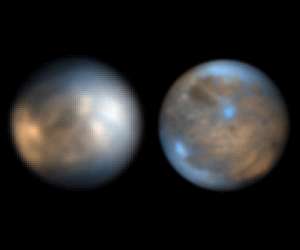ESA’s Mars Express has captured the rare moment of Mars’ small moon Deimos passing in front of Jupiter and its four largest moons – the focus of ESA’s upcoming Jupiter Icy Moons Explorer launching next year. Celestial alignments like these enable a more precise determination of the martian moons’ orbits.
Since arriving in orbit at the Red Planet in 2003, Mars Express routinely observes the planet’s geology. It also monitors the planet’s two moons Phobos and Deimos to understand more about their surface composition, in particular Phobos’ mysterious grooved terrain, and ultimately the moons’ puzzling origin. This includes tracking their orbits.
The moons experience strong tidal forces from Mars, causing their orbits to fluctuate constantly. Phobos orbits extremely close to Mars at just 6000 km, and is moving towards the planet, while Deimos moves away from it.
It is difficult to measure their orbits from Earth due to the brightness of Mars in comparison to these small bodies.
The fortuitous alignment of Deimos passing in front of Jupiter on 14 February 2022 enabled the position and orbit of Deimos to be more accurately pinpointed. That is, by measuring the duration of the occultation – when the light from one celestial body is blocked by another – the orbit can be calculated.
Such an alignment is extremely unusual because Deimos must be exactly in the orbital plane of Jupiter’s moons for the alignment to occur.
The animated sequence of 80 High Resolution Stereo Camera (HRSC) images shows the bumpy surface of the small and irregularly shaped 15 km-wide moon as it passed in front of Jupiter. The moons of Jupiter appear as small white specks, due to their distance of almost 750 million km from Mars Express. This staggering separation is five times the distance between Earth and the Sun.
The animation first shows Deimos passing in front of the icy moon Europa. The largest moon in the Solar System, Ganymede, is then obscured from view. The gas giant Jupiter, appearing as a large white spot in the centre, then vanishes behind Deimos.
Deimos then covers the extremely active volcanic moon Io, which is a similar size to Earth’s moon. Finally, the cratered moon Callisto disappears behind Deimos.
Deimos appears to move up and down in the animation due to the small swaying movements of Mars Express while it rotates to place the HRSC camera into position. The motion of the solar wings, which extend 12 m from the spacecraft, as well as two long radar antennas, also contribute to the small vibrations.
Jupiter and its three largest icy moons will be visited by the ESA-led JUpiter ICy moons Explorer (Juice) mission, scheduled to launch in 2023 for arriving in the Jupiter system in 2031. Juice will conduct flybys of the moons Ganymede, Callisto and Europa to study their surface and interior, which are thought to harbour oceans. These observations will help to study the conditions for the emergence of life in our Solar System and how planets are formed
After imaging the alignment with Jupiter, Mars Express cast its gaze towards the moment Deimos was blocked by its larger sibling, Phobos, which measures about 27 km along its longest axis. The animation is pieced together from 19 HRSC images, taken on 30 March 2022 when Phobos was 12 261 km away from the camera. From this perspective it is difficult to see the size difference between the martian moons, as Deimos is further from the camera at a distance of 27 907 km.
Much is still unknown about the formation and composition of Mars’ moons. Future missions, such as the JAXA-led Martian Moon eXploration mission (MMX) with contributions from ESA, will help to understand more. MMX will observe Deimos and place a lander on Phobos to collect and return a sample from the surface.
Precise orbit measurements, such as those provided by occultations, are required to pinpoint the exact positions of moons for future missions like MMX and Juice.
Mars Express observations of the moons over 14 years, including occultations with other Solar System objects, have enabled a correction of 1-2 km in our knowledge of where the moons are, with an accuracy on the order of a few hundred metres.
In June 2022, Europa’s orbital data was refined for the Juice mission through the occultation of a star. This occultation was predicted using ESA’s Gaia mission.
The new images demonstrate that Mars Express continues to shine a light on Mars, the immediate surroundings of the Red Planet, and beyond.
Related Links
Mars Express at ESA
The million outer planets of a star called Sol
|
We need your help. The SpaceDaily news network continues to grow but revenues have never been harder to maintain. With the rise of Ad Blockers, and Facebook – our traditional revenue sources via quality network advertising continues to decline. And unlike so many other news sites, we don’t have a paywall – with those annoying usernames and passwords. Our news coverage takes time and effort to publish 365 days a year. If you find our news sites informative and useful then please consider becoming a regular supporter or for now make a one off contribution. |
||
|
SpaceDaily Monthly Supporter $5+ Billed Monthly |
SpaceDaily Contributor $5 Billed Once credit card or paypal |
|

![]()
Sharpest Earth-based images of Europa and Ganymede reveal their icy landscape
Leicester UK (SPX) Oct 13, 2022
The cocktail of chemicals that make up the frozen surfaces on two of Jupiter’s largest moons are revealed in the most detailed images ever taken of them by a telescope on Earth.
Planetary scientists from the University of Leicester’s School of Physics and Astronomy have unveiled new images of Europa and Ganymede, two future destinations for exciting new missions to the Jovian system.
Some of the sharpest images of Jupiter’s moons ever acquired from a ground-based observatory, they reveal new … read more